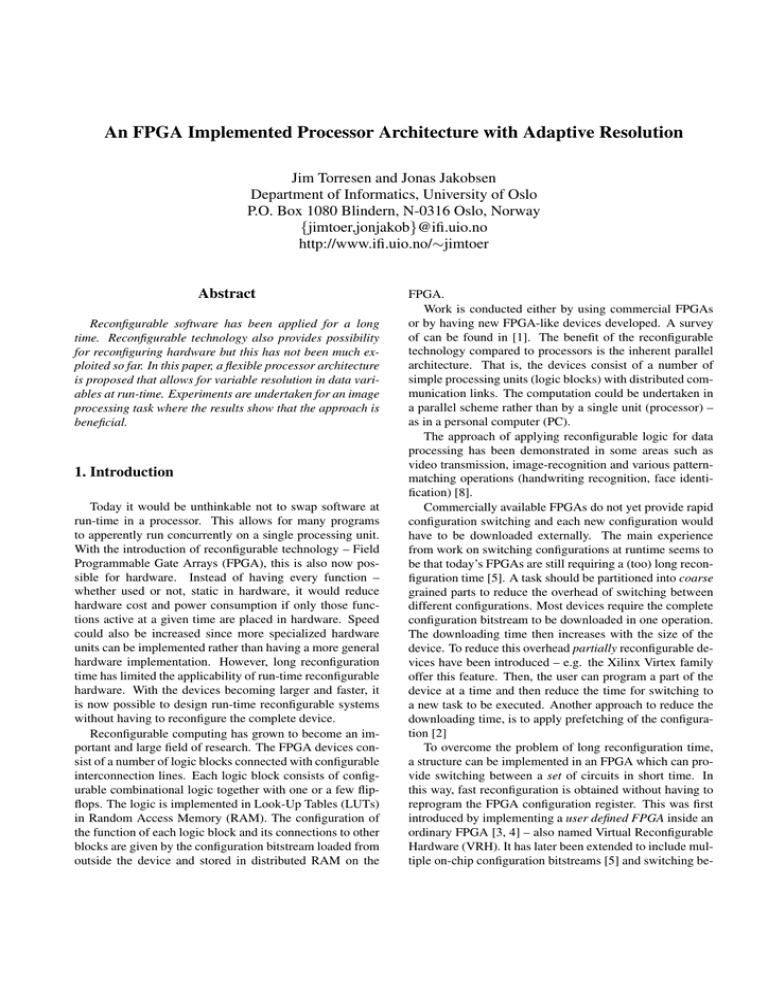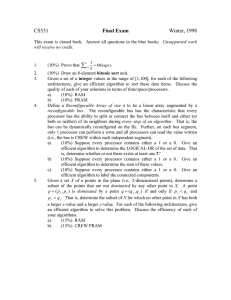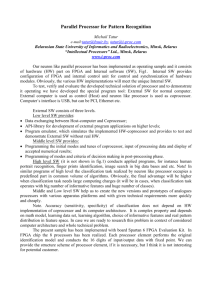An FPGA Implemented Processor Architecture with Adaptive Resolution
advertisement

An FPGA Implemented Processor Architecture with Adaptive Resolution
Jim Torresen and Jonas Jakobsen
Department of Informatics, University of Oslo
P.O. Box 1080 Blindern, N-0316 Oslo, Norway
{jimtoer,jonjakob}@ifi.uio.no
http://www.ifi.uio.no/∼jimtoer
Abstract
Reconfigurable software has been applied for a long
time. Reconfigurable technology also provides possibility
for reconfiguring hardware but this has not been much exploited so far. In this paper, a flexible processor architecture
is proposed that allows for variable resolution in data variables at run-time. Experiments are undertaken for an image
processing task where the results show that the approach is
beneficial.
1. Introduction
Today it would be unthinkable not to swap software at
run-time in a processor. This allows for many programs
to apperently run concurrently on a single processing unit.
With the introduction of reconfigurable technology – Field
Programmable Gate Arrays (FPGA), this is also now possible for hardware. Instead of having every function –
whether used or not, static in hardware, it would reduce
hardware cost and power consumption if only those functions active at a given time are placed in hardware. Speed
could also be increased since more specialized hardware
units can be implemented rather than having a more general
hardware implementation. However, long reconfiguration
time has limited the applicability of run-time reconfigurable
hardware. With the devices becoming larger and faster, it
is now possible to design run-time reconfigurable systems
without having to reconfigure the complete device.
Reconfigurable computing has grown to become an important and large field of research. The FPGA devices consist of a number of logic blocks connected with configurable
interconnection lines. Each logic block consists of configurable combinational logic together with one or a few flipflops. The logic is implemented in Look-Up Tables (LUTs)
in Random Access Memory (RAM). The configuration of
the function of each logic block and its connections to other
blocks are given by the configuration bitstream loaded from
outside the device and stored in distributed RAM on the
FPGA.
Work is conducted either by using commercial FPGAs
or by having new FPGA-like devices developed. A survey
of can be found in [1]. The benefit of the reconfigurable
technology compared to processors is the inherent parallel
architecture. That is, the devices consist of a number of
simple processing units (logic blocks) with distributed communication links. The computation could be undertaken in
a parallel scheme rather than by a single unit (processor) –
as in a personal computer (PC).
The approach of applying reconfigurable logic for data
processing has been demonstrated in some areas such as
video transmission, image-recognition and various patternmatching operations (handwriting recognition, face identification) [8].
Commercially available FPGAs do not yet provide rapid
configuration switching and each new configuration would
have to be downloaded externally. The main experience
from work on switching configurations at runtime seems to
be that today’s FPGAs are still requiring a (too) long reconfiguration time [5]. A task should be partitioned into coarse
grained parts to reduce the overhead of switching between
different configurations. Most devices require the complete
configuration bitstream to be downloaded in one operation.
The downloading time then increases with the size of the
device. To reduce this overhead partially reconfigurable devices have been introduced – e.g. the Xilinx Virtex family
offer this feature. Then, the user can program a part of the
device at a time and then reduce the time for switching to
a new task to be executed. Another approach to reduce the
downloading time, is to apply prefetching of the configuration [2]
To overcome the problem of long reconfiguration time,
a structure can be implemented in an FPGA which can provide switching between a set of circuits in short time. In
this way, fast reconfiguration is obtained without having to
reprogram the FPGA configuration register. This was first
introduced by implementing a user defined FPGA inside an
ordinary FPGA [3, 4] – also named Virtual Reconfigurable
Hardware (VRH). It has later been extended to include multiple on-chip configuration bitstreams [5] and switching be-
tween them would be possible in one clock cycle [6]. In
this paper, such methods are applied for designing a high
performance flexible processor in FPGA. At run-time, the
data buses are configured to the necessary data bus width in
a single clock cycle. When the buses consist of few lines, a
larger number of parallel processors can be configured.
The proposed reconfigurable processor is presented in
the next section. Results from real experiments on a template matching problem are included in Section 3. Finally,
Section 4 contains conclusions.
this is determined by the carry configuration (cc) bits. It
can be configured from 16 one bit ALUs up to one 16 bit
ALU (ALUs of different sizes are also possible). The first
configuration (16 one bit ALUs) is used in the following
experiments. The carry bits will only propagate within an
ALU and not between different ALUs. Thus, the configuration bit cci determines if an ALUi is to receive the previous
carry bit (ci−1 ). The complete configuration can be changed
in a single clock cycle. We are not aware of any other work
applying the same architecture.
2. A Flexible Processor Architecture
2.1. Registers
In this section, we propose a processor with flexible resolution. It can be configured to compute with bus width
from 1 to 16 bit. This width determines the number of parallel processing elements being available. E.g. with 1 bit
processing, 16 parallel processing elements would be available. A block level description of the flexible processor is
included in Figure 1.
A register bank with 16 16-bit registers has been implemented. Two registers can be addressed concurrently for
the input to the ALU while a third register stores the result
of an operation. When less than 16 bit is used for data, several words are stored within the same register. E.g. with 1
bit words, there will be 16 words in a single register (a separate carry register is necessary for storing the carry bit for
each word after ADD operation). To add 1 bit results together into a 16 bit number – as necessary in the following
experiments, the “Add 16 bit” unit is applied.
Control
Memory
2.2. Instruction Set
Add 16 bit
MUX
Registers
The Control unit (see Figure 1) receives instructions
from the memory, and by a state machine it generates appropriate control signals to the different units in the processor. The instructions are stored in a memory bank on the
Celoxica board (see the next section). The coding of the
instructions is given in Table 1.
X
ALU
ALU
Z
Y
Figure 1. Processor architecture.
To limit the size of the control logic [7], the number of
configuration bits is limited as much as possible. Thus, it is
emphasized on using the same hardware unit for the various
configurations as much as possible.
x1 y1
cc2
ccn
x2 y2
c1
c2
xn yn
cn
cn-1
# of bit
Comand
2
Data
16
Reg1
4
Reg2
4
Out
1
RegOut
4
MUX
1
Table 1. Instruction coding.
Each field represents the following:
• Command: Determines the instruction: Load a register (00),
ALU performs AND operation (10) or ALU performs ADD
operation (11). Command 11 is also used for “Add 16 bit” –
see “MUX”.
• Data: This is either data to be stored in a register (command
00) or the carry configuration of the ALU (command 01/11).
z1
z2
zn
Figure 2. Illustration of flexible ALU sizes.
The Arithmetic Logic Unit (ALU) is the main part of the
system and contains the reconfigurable part of the processor. Each ALU can perform either AND or adder function.
More functionality would be added in the future. It is configurable for up to 16 bit data bus. These 16 bit can be
partitioned by the user as illustrated in Figure 2. The splitting of the carry chain determines the size of each ALU and
• Reg1, Reg2 and RegOut: Reg1 and Reg2 are input operands
and RegOut is the register where the result of an operation is
stored.
• Out: The parameter determines if the result is to be stored in
a register or in external memory.
• MUX: This parameter determines if the result should be from
the ALU or “Add 16 bit” (see Figure 1). The latter operation
is used after 1-bit operations (AND in the following experiments) to add the results from 16 1-bit operations.
2.3. Prototyping Platform
The system has been implemented in VHDL (Very high
speed integrated circuit Hardware Description Language)
for a Xilinx Virtex 1000-6 BG560 FPGA. The experiments
have been performed on a Celoxica RC1000-PP board with
PCI (Peripheral Component Interconnect) interface. The
FPGA is interfaced to the PCI interface through four memory banks each of 2 Mbyte.
3. Running Template Matching on the Processor
To demonstrate the performance of the processor, we selected an application from image processing. We are involved in a project on speed limit sign recognition and this
includes a number of time consuming steps. One of the
most computational demanding is template matching for
detecting red circles on signs in an input image. This includes passing six different sized templates over the image
as illustrated for one template in Figure 3. That is, each template of different size is moved over the image one at time.
If the best match at a given position in the image is satisfactory, it is concluded that a sign is present in the image and
recognition of the sign content follows.
code for the processor looks as follows for one template for
one pixel position in the image:
1. Load a part of a template in register r1.
2. Load a part of the image in register r2.
3. Perform bitwise XNOR between r1 and r2 and store
the results in register r3.
4. “Add 16 bit” in r3 and store the result in register r4.
5. ADD register r4 and r5 and store result in r5.
6. While (not finished with template) return to 1.
PCI Interface
Memory 1
Memory 2
Processor 1
Processor 2
Processor 3
Processor 4
Select highest
score
Control
+
Program
Processor 5
Processor 6
Figure 3. Template matching in image.
Figure 4. Architecture with six processors.
The template is not applied on the raw input but rather
on a bit level image with red color extracted – i.e. one bit
for each pixel with value “1” for red color and “0” for not
red color. Thus, both the templates as well as the image are
represented with binary data. For this reason it is an interesting application to run on our processor to demonstrate its
performance.
The processing steps will be as follows for each position
of the template in the red color extracted image: Perform
XNOR (both pixels are either 0 or 1) between template and
image. Then, add the results together. The latter operation
is performed with the “Add 16 bit” unit in Figure 1. The
A system was implemented on FPGA with one processor
for each template. The six templates were stored in on-chip
RAM on the FPGA while the image was stored on external
SRAM memory (Memory 1) as illustrated in Figure 4. Each
processor is as outlined in Section 2. They are controlled
in a Single Instruction Multiple Data (SIMD) way by the
common control unit. For each position template matching
is undertaken in the input image, the best match (of the six
templates) is stored in Memory 2.
The size of each template is 64x64 pixels (most templates are smaller but it was practical in these first experiments having them of the same size). This corresponds to
256 words of 16 bit length each. The binary image is 640
x 480 pixels. To simplify the hand-coded processor code,
there were made a few simplifications that would need to be
taken care of in a real system. This includes how the templates are shifted across the image. However, this should
not influence the comparison of the performance speed. The
design filled the XCV1000 device to a large degree as seen
in Figure 5.
duced. Correct operation was confirmed with verifying that
the two implementations gave the same output result.
4. Conclusions
In this paper, a processor with parallel and flexible ALUs
has been introduced. It allows for adapting the data bus
width to the problem at hand. Experiments for an image
template matching problem show that such a processor realized on an FPGA can be faster than running the same application on a PC. Future work consists of improving the
processor and testing it for other applications.
Acknowledgments
Figure 5. Layout of the FPGA design with six
processors.
For comparison, equivalent code was implemented on
a Pentium III PC with a clock speed of 1GHz. This is
higher than what most embedded processors are running at
today. Preliminary experiments showed that for the PC, it
was more beneficial storing only one pixel for each memory location rather than 16 as for the FPGA processor. Thus,
this was applied for the following experiments. Further, the
PC program applied the same simplifications as the FPGA
regarding template matching to make the two implementations comparable in speed of performance.
The following experiments are concerned only with one
step of the processing (template matching). This is mainly
due to lack of programming tools for our system requiring hand coding at a very low (and time consuming) level.
However, with most of the other processing steps being on
binary data, we believe the architecture will be effective for
our application. Moreover, with FPGA it is also possible to
implements parts of the processing as dedicated hardware.
3.1. Results
The FPGA design was able to run at 35MHz. This resulted in a execution time of 2.152s for the template matching on one image. The PC running at 1GHz needed 6.379s
for the same task. Thus, the FPGA architecture was close
to three times faster than the PC. There is a potential in
increasing the clock speed of the FPGA by improving the
design. For a real system both these implementations will
be too slow. However, it is not necessary to do template
matching for every pixel in the image (as here) and if this
is not undertaken, execution time will be substantially re-
We are thankful for the PCI interface designed by
Fearghal Morgan at National University of Ireland, Galway
that was made available for this project.
The research presented in this paper is a part of the
project Biological-Inspired Design of Systems for Complex
Real-World Applications (project number 160308/V30)
funded by the Research Council of Norway.
References
[1] R. Hartenstein. A decade of reconfigurable computing: A visionary retrospective. In Proc. of Int. Conference on Design
Automation and Testing in Europe - and Exhibit (DATE). Munich, Germany, 2000.
[2] J. Resano et al. A reconfiguration manager for dynamically
reconfigurable hardware. IEEE Design and Test of Computers, 22(5):452–460, September – October 2005.
[3] L. Sekanina and R. Ruzicka. Design of the special fast reconfigurable chip using common FPGA. In Proc. of Design
and Diagnostics of Electronic Circuits and Systems - IEEE
DDECS’2000, pages 161–168, 2000.
[4] J. Torresen. A divide-and-conquer approach to evolvable
hardware. In M. Sipper et al., editors, Evolvable Systems:
From Biology to Hardware. Second Int. Conf., ICES 98, pages
57–65. Springer-Verlag, 1998. Lecture Notes in Computer
Science, vol. 1478.
[5] J. Torresen. Reconfigurable logic applied for designing
adaptive hardware systems. In Proc. of the International
Conference on Advances in Infrastructure for e-Business, eEducation, e-Science, and e-Medicine on the Internet (SSGRR’2002W). Scuola Superiore G. Reiss Romoli, 2002.
[6] J. Torresen and K. Vinger. High performance computing by context switching reconfigurable logic. In Proc. of
the 16th European Simulation Multiconference (ESM2002),
pages 207–210. SCS Europe, June 2002.
[7] R. Turner and R. F. Woods. Design flow for efficient FPGA
reconfiguration. In Proc. of International Conference on Field
Programmable Logic and Applications (FPL 2003). Springer
Verlag, LNCS 2778, 2003.
[8] J. Villasenor and W. Mangione-Smith. Configurable computing. Scientific American, (6), 1997.





